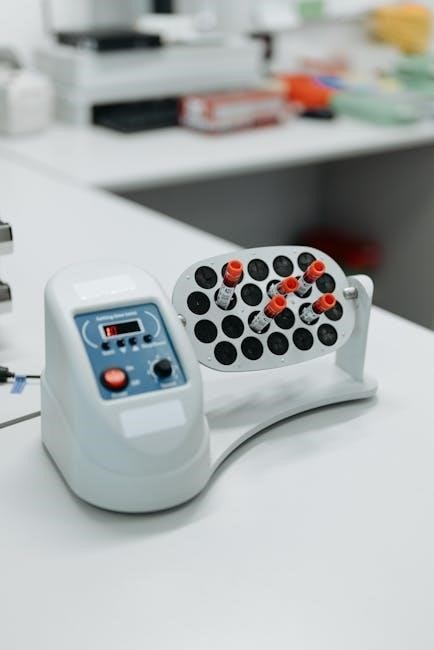Kinesio taping is used for rotator cuff injuries to reduce pain and improve function‚ with elastic tape applied to facilitate muscle movement and promote healing‚ using a specific method and technique always․
Background Information on Rotator Cuff Tendonitis
Rotator cuff tendonitis is a common shoulder pathology that causes pain and limits joint movement‚ impairing function and affecting daily activities․ According to recent studies‚ rotator cuff tendonitis is one of the most prevalent shoulder injuries‚ resulting from inflammation of the tendons surrounding the shoulder joint․ The condition can be caused by various factors‚ including repetitive strain‚ poor posture‚ and direct trauma to the shoulder․ Symptoms of rotator cuff tendonitis include pain‚ weakness‚ and limited range of motion‚ making it essential to seek medical attention for proper diagnosis and treatment․ A thorough understanding of the condition is crucial for developing effective treatment strategies‚ including the use of Kinesio taping․ By examining the underlying causes and mechanisms of rotator cuff tendonitis‚ healthcare professionals can provide targeted interventions to alleviate symptoms and promote healing․ This knowledge is essential for informing treatment decisions and improving patient outcomes․
Objectives of Using Kinesio Taping for Rotator Cuff Treatment
Objectives include reducing pain‚ improving function‚ and enhancing rehabilitation outcomes using Kinesio taping methods and techniques always effectively․
Effectiveness of Kinesio Taping in Rotator Cuff Injuries
The effectiveness of Kinesio taping in rotator cuff injuries is a topic of interest‚ with studies examining its impact on pain‚ function‚ and rehabilitation outcomes․ According to research‚ Kinesio taping may assist in altering specific rotator cuff muscle activity‚ which can be beneficial in the treatment of rotator cuff injuries․ The application of Kinesio taping has been shown to have a positive effect on shoulder joint movements and function‚ with some studies reporting improved outcomes in patients with rotator cuff tendonitis․ However‚ the current evidence is limited‚ and further research is needed to fully understand the effectiveness of Kinesio taping in rotator cuff injuries․ Overall‚ Kinesio taping appears to be a promising adjunctive treatment for rotator cuff injuries‚ and its use may be considered as part of a comprehensive rehabilitation program․ The use of Kinesio taping in conjunction with other treatments may enhance rehabilitation outcomes and improve patient function․

Understanding Kinesio Taping Method and Its Application
Education is crucial for Kinesio taping method and application‚ with a specific technique and skill level required for effective treatment of rotator cuff injuries always needed and used correctly․
Education and Skill Level Required for Kinesio Taping
The education and skill level required for Kinesio taping is a crucial element in its effectiveness‚ with a specific technique and method of application needed to achieve optimal results․
The Kinesio Taping Method has a underlying philosophy of care that influences its effectiveness‚ with education being the key to understanding this philosophy․
Tape With Wisdom refers to the skill level of medical professionals‚ with Dr․ Kase noting that there is wisdom in Kinesio Tape itself‚ and an education program is available to teach this skill․
This education program is designed to teach medical professionals the correct technique and method of application‚ with the goal of achieving optimal results for patients with rotator cuff injuries․
The program includes training on the different types of tape and how to apply them‚ as well as how to assess patient needs and develop a treatment plan․
By providing medical professionals with the education and skills they need‚ the Kinesio Taping Method can be used effectively to treat rotator cuff injuries and improve patient outcomes․
With the right education and skill level‚ medical professionals can use Kinesio taping to reduce pain and improve function in patients with rotator cuff injuries‚ and improve their overall quality of life․
The education and skill level required for Kinesio taping is an important aspect of its effectiveness‚ and medical professionals should prioritize this education to provide the best possible care for their patients․
By doing so‚ they can help patients achieve optimal results and improve their overall health and well-being․
This is especially important for patients with rotator cuff injuries‚! who can benefit greatly from the effective use of Kinesio taping․
With the right education and skill level‚ medical professionals can make a positive impact on the lives of their patients‚ and help them achieve optimal health and well-being․
The Kinesio Taping Method is a valuable tool in the treatment of rotator cuff injuries‚ and with the right education and skill level‚ medical professionals can use it to achieve optimal results․
This is an important consideration for medical professionals who want to provide the best possible care for their patients‚ and help them achieve optimal health and well-being․
The education and skill level required for Kinesio taping is an important aspect of its effectiveness‚ and medical professionals should prioritize this education to provide the best possible care for their patients with rotator cuff injuries․

Clinical Effects of Kinesio Taping on Rotator Cuff Injuries
Clinical effects of kinesio taping on rotator cuff injuries include reduced pain and improved shoulder function‚ with studies showing positive outcomes using the kinesio taping method always effectively․
Short-Term Effects of Kinesio Taping on Shoulder Pathology
The short-term effects of kinesio taping on shoulder pathology have been studied‚ with results showing that kinesio taping can be effective in reducing pain and improving function in patients with rotator cuff injuries․
Studies have found that kinesio taping can have a positive effect on shoulder pathology‚ particularly in the short term‚ with improvements in pain and function reported by patients․
However‚ more research is needed to fully understand the effects of kinesio taping on shoulder pathology‚ including the long-term effects and potential benefits for patients with different types of shoulder injuries․
Overall‚ the short-term effects of kinesio taping on shoulder pathology are promising‚ and further study is warranted to explore the potential benefits of this treatment approach for patients with rotator cuff injuries and other shoulder pathologies․
Kinesio taping is a non-invasive and relatively low-cost treatment option‚ making it a potentially attractive treatment approach for patients with shoulder injuries․

Comparison of Kinesio Taping with Other Treatment Methods
Kinesio taping is compared to physical therapy and medications for rotator cuff treatment‚ with varying results and effectiveness‚ using different treatment approaches and methods always․
Importance of Proper Application and Technique in Kinesio Taping
The proper application and technique of Kinesio taping is crucial for effective treatment of rotator cuff injuries‚ as incorrect application can lead to reduced effectiveness or even adverse effects․
The technique involves applying the tape in a specific manner to facilitate or inhibit muscle movement‚ and to promote healing and reduce pain․
A thorough understanding of the underlying anatomy and physiology of the rotator cuff is necessary to apply the tape correctly․
Additionally‚ the tape should be applied with the correct amount of tension‚ as too much or too little tension can affect the outcome․
Education and training are essential for medical professionals to master the proper application and technique of Kinesio taping‚ and to ensure that patients receive the maximum benefit from this treatment method․
The importance of proper application and technique cannot be overstated‚ as it can significantly impact the effectiveness of Kinesio taping in treating rotator cuff injuries․
Proper application and technique are essential for optimal results․

on the Use of Kinesio Taping for Rotator Cuff Injuries
Kinesio taping is a valuable treatment option for rotator cuff injuries‚ offering a non-invasive and non-pharmacological approach to managing pain and improving function․
The use of Kinesio taping has been shown to be effective in reducing pain and improving range of motion‚ making it a useful adjunct to other treatment methods․
Overall‚ the available evidence suggests that Kinesio taping can be a useful tool in the management of rotator cuff injuries‚ and its use should be considered as part of a comprehensive treatment plan․
Further research is needed to fully understand the effects of Kinesio taping on rotator cuff injuries‚ but the current evidence is promising․
Kinesio taping is a simple and cost-effective treatment option that can be used in a variety of settings‚ making it a valuable resource for clinicians and patients alike․
The conclusion is that Kinesio taping is a useful treatment option for rotator cuff injuries‚ and its use should be considered as part of a comprehensive treatment plan‚ with proper application and technique being essential for optimal results always․
